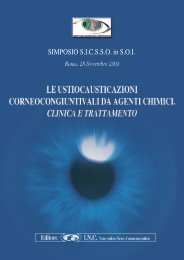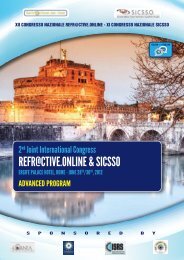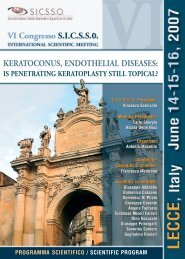1st EuCornea Congress
1st EuCornea Congress
1st EuCornea Congress
Create successful ePaper yourself
Turn your PDF publications into a flip-book with our unique Google optimized e-Paper software.
<strong>1st</strong> <strong>EuCornea</strong> <strong>Congress</strong> venice, 17-19 june 2010<br />
KEYNOTE SPEAKERS<br />
26<br />
Dua, Harminder Singh<br />
Management of Ocular surface chemical burns<br />
H.S. Dua, D. Said<br />
University of Nottingham, Nottingham, UK<br />
Chemical burns of the ocular surface (OS) usually follow domestic or<br />
workplace accidents and can have devastating consequences. Fortunately<br />
the majority are mild. Acute stage management is of paramount importance<br />
to encourage a favourable prognosis. Besides the eyes, initial examination<br />
should include the surrounding facial skin, oropharynx, respiratory passages<br />
and the upper gastrointestinal tract for damage due to inhalation or ingestion<br />
of the chemical. Three stages of OS burns are recognised: Immediate: Direct<br />
result of the injury and extending up to one week. Intermediate: After the<br />
first week when the host healing response has set in, and extending up to<br />
three weeks and Late: After the first three weeks and extending to several<br />
months. The signs are associated with repair and regeneration or lack<br />
thereof. Treatment consists of copious irrigation and removal, surgically if<br />
necessary, of any retained chemical. Medical treatment is directed towards<br />
promoting epithelisation and wound healing (ascorbate, autologous serum,<br />
possibly steroids); neutralising proteases and enzymes (sodium citrate,<br />
acetylcystiene, doxycycline); preventing or treating infection (antibiotics);<br />
controlling intraocular pressure (acetazolamide); cycloplegics and others.<br />
Surgical procedures such as excision of necrotic material, amniotic<br />
membrane transplant, conjunctival patch grafting from the other uninvolved<br />
eye, tenoplasty, gluing and lid procedures to ensure eye cover and sequential<br />
sector conjunctival epitheliectomy may also be required in the immediate and<br />
intermediate stages. Late stage ocular surface reconstruction is achieved by<br />
auto or allo limbal transplants or of ex-vivo expanded sheets.<br />
Grabner, Günther<br />
Keratoprosthesis<br />
G. Grabner<br />
University Eye Clinic,Paracelsus Medizinische Privat-Universität Salzburg Austria<br />
This review lecture will analyse the keratoprosthesis (Kpro´s) currently<br />
available as valid methods for treating very severe anterior segment disease,<br />
in regard to the initial clinical findings, the potential complications encountered<br />
and the surgical requirements needed for the different techniques. Factors<br />
considered are: involvement of one eye only or both eyes, limbal stem<br />
cell availability and ‘dry eye’ status, availability of healthy teeth, as well as<br />
surgical requirements and those needed for follow-up. A systematic approach<br />
to the surgical options available for different stages of a variety of anterior<br />
segment diseases and currently published results of VA and complications<br />
and information about a new, freely available database will be given. With<br />
this method it will become clear that some popular reconstructive surgical<br />
techniques should be avoided in cases where a very low chance of success<br />
is to be expected (e.g. amniotic membrane and stem cell transplantation and<br />
/or PKP in very dry eyes -> these would have to be treated e.g. with OOKP).<br />
Following a simple clinical decision path the anterior segment surgeon will<br />
be presented with standardized guidelines for treating those patients where<br />
conventional surgical procedures have to be avoided and replaced by the<br />
rather infrequently performed keratoprosthesis techniques.<br />
Güell, José Luis<br />
PK: Gold Standard in PK, indications and future trends<br />
J. Güell<br />
Barcelona Spain<br />
The rationale of lamellar keratoplasty has always been to substitute<br />
only those corneal layers with irreversible alterations. Both, anterior and<br />
posterior lamellar techniques, have obvious theoretical advantages in front<br />
of penetrating keratoplasty (PKP) and, especially during these last few<br />
years, improvements in the surgical techniques and the mastering in the<br />
use of microkeratomes have completely change the standart for the corneal<br />
surgeon. Two very robust lamellar techniques are becoming the regular<br />
approach worldwide for a number of corneal problems: DALKP (Deep<br />
anterior lamellar keratoplasty ) using the ‘big-bubble’ approach (either with<br />
air or viscoelastic) and DSEK (Descemet Stripping Endothelial keratoplasty).<br />
Despite their widespread use, it must be recognized that we do not yet have<br />
enough long-term data ( for example percentage of 20/40 and 20/20 at 5<br />
years, incidence of re-transplantation in relation with the original disease, etc)<br />
to fully and properly compare with penetrating keratoplasty, technique that<br />
have been the standard approach for corneal transplantation for more than a<br />
century. What we know today are general preliminary data such as in DSEK:<br />
final visual results are slightly worse than after PKP for some investigators<br />
(probably this will improve once Descemet alone -DMEK- might be<br />
transplanted on a regular basis), visual rehabilitation time are comparable or<br />
slightly better for DSEK, final refraction is clearly superior for DSEK, chronic<br />
endothelial loss seems superior for DSEK, endothelial rejection episodes<br />
must be quite similar and the strength of the wound is also obviously superior<br />
for DSEK. Its main limitations are a strongly affected anterior stroma and/<br />
or the need of precise surgical manouvres in the anterior chamber. In these<br />
latter situations, PKP is clearly advantageous, also for those surgeons<br />
defending the lamellar approach In DALKP, also final visual results are slightly<br />
worse that after PKP with a similar visual rehabilitation time, final refraction is<br />
also similar to PKP, being the main advantage the lower chronic endothelial<br />
cell loss (surgical trauma, preserved endothelium and rejection episodes<br />
are the three mainstones). Regarding the strength of the wound, there are<br />
different opinions, and only long-term studies will clarify its incidence and<br />
severity, as we all know about PKP. Its main limitation appears in those cases<br />
where we are unable to evaluate or have doubts about the status of the<br />
endothelium (infectious keratitis with important intraocular involment, herpetic<br />
diseasse with a dense posterior stromal scar, keratoconic, hydrops, etc).<br />
Again, in these situations PKP is a better approach, also for those surgeons<br />
defending lamellar surgery. On the other hand and as it has become quite<br />
common during the last 20 years, new refractive surgery technology is being<br />
applied by corneal surgeons (topographers, intracorneal ring segments,<br />
femtosecond lasers, etc). The femtosecond laser has improved precision,<br />
quality and repetibility of the lamellar cut (becoming perhaps the ‘standard’<br />
knive for the lamellar surgeon in the near future) but also allows the creation<br />
of new wound designs for PKP. We, as some others groups worldwide, have<br />
been exploring different techniques, such as the so called ‘top.hat’ for PKP.<br />
Again, preliminary data seems to demonstrate a higher resistance of the<br />
penetrating wound, compared with standard PKP, a quicker and better visual<br />
and refractive rehabilitation (perhaps able to compete with DSEK), some<br />
immunological advantages (reduction of the anterior wound diameter) all<br />
together with the classical advantages of penetrating surgery (visual acuity<br />
and quality and intraocular manouvres at the time of the surgery) As most<br />
of us will agree, only prospective properly designed comparative long-term<br />
studies will demonstrate the superiority of one technique over the others for a<br />
particular indication but, in any case, penetrating keratoplasty will remain the<br />
standard for a long time and worldwide for a variety of clinical situations<br />
Hannush, Sadeer B.<br />
Amniotic membrane transplantation and fibrin sealant: A<br />
true advance in ocular surface reconstruction<br />
S. Hannush, Pennsylvania, USA<br />
The lecture will emphasize the advantages and limitations of amniotic<br />
membrane transplantation in ocular surface reconstruction. The potential<br />
advantages of fibrin sealant over suture fixation will be discussed.<br />
Malecaze, Francois<br />
Revision on corneal wound healing<br />
F. Malecaze<br />
Toulouse, France<br />
Revision on corneal wound healing F Malecaze Corneal transparency<br />
depends on the scarring quality after a traumatic wound of the cornea, but<br />
also after refractive corneal surgery which goal is to optically correct refractive<br />
abnormalities, such as myopia. The wound healing secondary to traumatic<br />
lesions (chemical, immunological, infectious…) or after refractive surgery,<br />
involves epithelial/fibroblast interactions, molecules of the extracellular<br />
matrix, and soluble mediators such as growth factors, which can lead to the<br />
formation of corneal tissue scarring impairing its transparency. On injury,







